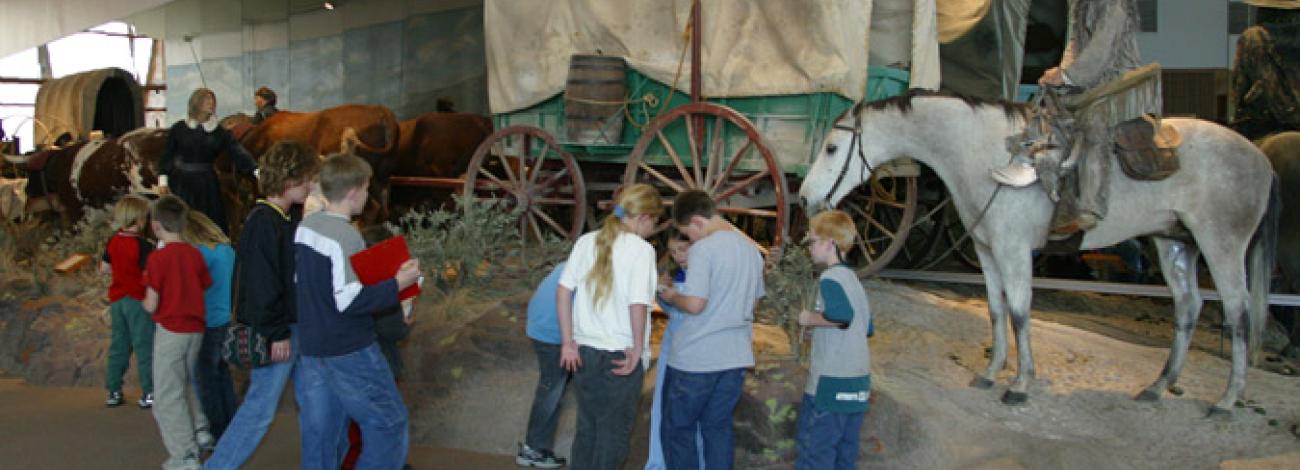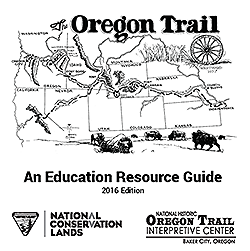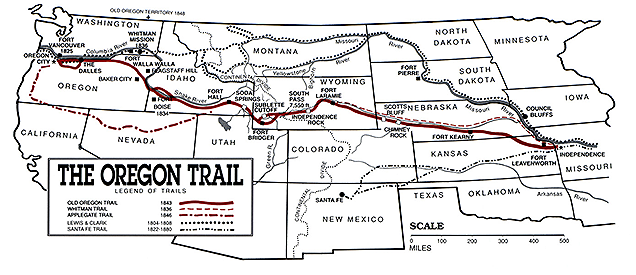
History and Educational Resources
School Field Trip Information
A park ranger can meet your group at the historic ruts or the wagon encampment area for a 45 minute program (weather permitting). To schedule your visit, please call 541-523-1843 or email BLM_OR_NH_Mail@blm.gov.
Rangers can also make classroom visits to any public, private, or home school in Baker County. To schedule your visit, please call 541-523-1843 or email BLM_OR_NH_Mail@blm.gov.
The Oregon Trail
The Oregon Trail was a wagon road stretching 2170 miles from Missouri to Oregon's Willamette Valley. It was not a road in any modern sense, only parallel ruts leading across endless prairie, sagebrush desert, and mountains. From the 1840s through the 1880s, thousands trekked westward, carrying only a few belonging and supplies for the journey, and settling on the western frontier, forever changing the American West.
During eight decades in the 1800s the Oregon Trail served as a natural corridor as the United States grew from the eastern half of the continent toward the west coast. The Oregon Trail ran approximately 2,000 miles west from Missouri toward the Rocky Mountains and ended in Oregon's Willamette Valley. The California Trail branched off in southern Idaho and brought miners to the gold fields of Sierra Nevada. The Mormon Trail paralleled much of the Oregon Trail, connecting Council Bluffs to Salt Lake City.
"Is there a list of all the pioneers?" and other FAQs
Migration over the Oregon Trail involved a huge number of people, moving to different locations for different reasons. In a free society, emigrants were not required to sign a roster to leave, or to present a passport at borders, or sign in anyplace upon arrival. There is no comprehensive list of all the pioneers.
"Did the children on the wagon trains have to go to school?"
What was life like for pioneer children on the Oregon Trail? Many children made the five month trek west with their families. It's estimated that 40,000 of the emigrants were children.
Prairie Schooners and Wagon Trains
The wagon train was moveable community for four to six months along the trail. Each evening, the wagon encampment typically grouped into a circle, forming a temporary corral. Around the circle, tents and bedrolls provided the shelter for exhausted pioneers. A few guards kept an eye on the grazing livestock and watched for signs of trouble from wild animals or potential thieves. At sunrise, four o'clock or so, the guards called out or fired their rifles to wake the camp and start another day on the long and dusty trail.
Teaching about the Oregon Trail
We offer a self-guided activity-based program that students can follow at their own speed, individually or in groups. We also offer living history interpretive programs, exhibits, multi-media presentations, and four miles of trails that interpret the Oregon Trail, natural history, and mining history.
Our education guide was updated in 2016, and contains five lesson plans for classroom or homeschool use.

- Oregon Trail Education Resources Guide (2016 Version)
- Teachers Version of Education Resources Guide 2016
- Recursos en español: Para un extracto en español, haga clic aquí
- Hechos básicos del rastro de Oregon
Here are some additional activities to enhance your classroom visit to the Interpretive Center.
- Scavenger Hunt - to print: select two-sided with binding on short edge
- Exhibit Bingo Cards - Four variations of a visual scavenger hunt. Great for younger visitors!
- Connect the Dots
Map of the Oregon Trail

To print this map, please set your printer to either "Letter Landscape" or "Legal Landscape." The PDF file is about 6" x 13.5"; however, it will print clearly on Letter Landscape as well.
Every Kid Outdoor Pass for 4th Graders
The Every Kid Outdoors program is a nationwide movement to help build the next generation of environmental stewards. Beginning each September 4th graders (including home-schooled and free-choice learners 10 year of age) can download a free voucher to gain unlimited, free access for themselves and their families to any federal lands or waters during that school year and following summer.
Teachers can also print out vouchers for their 4th grade students and bring them to the Interpretive Center with their class to exchange for the actual 4th grade pass. For more information, check out the Every Kid Outdoor website at everykidoutdoors.gov.
Junior Rangers
Explore and celebrate the multiple uses of public lands. The BLM’s Junior Ranger Program allows you to engage in recreation, learning, and stewardship of your public lands. We offer several Junior Ranger and Junior Explorer books to complete at the National Historic Oregon Trail Interpretive Center.
